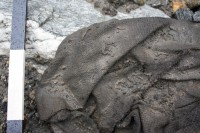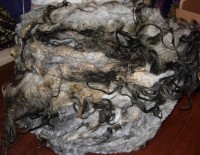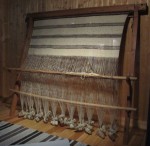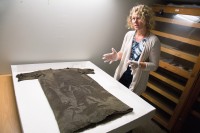 In 2011, archaeologists exploring the rapidly melting Lendbreen glacier in Norway’s Breheimen National Park discovered an intact woolen tunic dating to between 230 and 390 A.D. It is the oldest garment ever found in Norway, and it wasn’t new when for unknown reasons it was left on a glacier to freeze solid. There are several patches and the sleeves were sewn onto the tunic after the original manufacture. Although it could have been decades old, it was still entirely in wearable condition, and yet it was found bundled up and covered in horse manure. Archaeologists speculated that its 5’9″ wearer removed it believing himself to be hot, a common delusion caused by hypothermia, but it may also have been put to some other purpose rather than as clothing.
In 2011, archaeologists exploring the rapidly melting Lendbreen glacier in Norway’s Breheimen National Park discovered an intact woolen tunic dating to between 230 and 390 A.D. It is the oldest garment ever found in Norway, and it wasn’t new when for unknown reasons it was left on a glacier to freeze solid. There are several patches and the sleeves were sewn onto the tunic after the original manufacture. Although it could have been decades old, it was still entirely in wearable condition, and yet it was found bundled up and covered in horse manure. Archaeologists speculated that its 5’9″ wearer removed it believing himself to be hot, a common delusion caused by hypothermia, but it may also have been put to some other purpose rather than as clothing.
 Its exceptional condition and the visible repairs afford researchers a unique chance to examine Iron Age wool, textile production and garment construction. To learn more about how the tunic was made, two museums — the University of Olso’s Museum of Cultural History and the Norwegian Mountain Museum in Lom — will create reproductions using traditional techniques. It’s going to be a highly detailed and complex process that enlists the labour of expert craftsmen.
Its exceptional condition and the visible repairs afford researchers a unique chance to examine Iron Age wool, textile production and garment construction. To learn more about how the tunic was made, two museums — the University of Olso’s Museum of Cultural History and the Norwegian Mountain Museum in Lom — will create reproductions using traditional techniques. It’s going to be a highly detailed and complex process that enlists the labour of expert craftsmen.
First they have to source the proper wool. Ancient Norwegian sheep breeds had two kinds of wool: the long, stiff, water-resistant outer coat known as overhair, and the soft, fluffy inner layer known as underwool. The two layers were used to make different kinds of garments. The overhair was ideal for outerwear to protect from the elements, but the Lendbreen tunic was made almost entirely from underwool.
 Wool from most modern sheep breeds is akin to the ancient underwool, but wild breeds still have the two layers. Researchers are therefore securing the wool of Norwegian wild sheep from a farmer at Hareid in northwestern Norway’s Sunnmøre region. Then traditional wool spinnery at Selbu Spinneri wll separate the overhair from the underwool by hand. They have no idea how long this painstaking work will take (my guess is a long damn time). Once the overhair has been plucked out, the spinners will spin some of the underwool on a hand spindle just as it would have been done in the Iron Age. (Spinning wheels were invented in the 18th century. EDIT: According to the linked release about the project, that is, but several erudite commenters below have corrected the contention. I suspect is a translation error and they were referring to mechanized spinning.) The project can’t afford to spin all the wool they need by hand, so some of it will be spun mechanically.
Wool from most modern sheep breeds is akin to the ancient underwool, but wild breeds still have the two layers. Researchers are therefore securing the wool of Norwegian wild sheep from a farmer at Hareid in northwestern Norway’s Sunnmøre region. Then traditional wool spinnery at Selbu Spinneri wll separate the overhair from the underwool by hand. They have no idea how long this painstaking work will take (my guess is a long damn time). Once the overhair has been plucked out, the spinners will spin some of the underwool on a hand spindle just as it would have been done in the Iron Age. (Spinning wheels were invented in the 18th century. EDIT: According to the linked release about the project, that is, but several erudite commenters below have corrected the contention. I suspect is a translation error and they were referring to mechanized spinning.) The project can’t afford to spin all the wool they need by hand, so some of it will be spun mechanically.
 Because the tunic was woven in a diamond twill pattern, the Selbu Spinneri will sort the underwool into shades of grey so the darkest and lightest wool can be woven into this distinctive pattern. Once spun, the yard will be woven into the diamond twill textile on a vertical warp-weighted loom, an ancient machine that is simple, functional and slow.
Because the tunic was woven in a diamond twill pattern, the Selbu Spinneri will sort the underwool into shades of grey so the darkest and lightest wool can be woven into this distinctive pattern. Once spun, the yard will be woven into the diamond twill textile on a vertical warp-weighted loom, an ancient machine that is simple, functional and slow.
Consisting of a simple upright frame with two horizontal beams, the loom is leant against a wall. The vertical warp threads hang freely from the upper beam. To keep the warp threads taut, stones or other heavy weights are hung from the bottom of bundles of warp threads. The weaving is done from the top of the loom downwards and every line of weft thread is beaten tightly in place with a sword beater.
The textiles will be woven by handweaver Lena Hammarlund from Gothenburg. Lena specializes in reconstructing prehistoric textiles.
Lena Hammarlund from Gothenburg, you are so cool.
After Ms. Hammarlund does her thing, the woven textile will be sewn into two tunics by traditional tailors from Heimen Husflid in Oslo. Once the tunics are completed, they will go on display, one at the Museum of Cultural History in Oslo, the other at the Lom museum. The latter is just six miles east of the Lendbreen glacier and has a large collection of artifacts recovered since the thaws began accelerating in 2006.
 Marianne Vedeler, Associate Professor at the Museum of Cultural History at the University of Oslo, hopes the reconstruction won’t just give us a new understanding of the manufacture of ancient woollen clothing, but will also have an impact on Norwegian clothing design today.
Marianne Vedeler, Associate Professor at the Museum of Cultural History at the University of Oslo, hopes the reconstruction won’t just give us a new understanding of the manufacture of ancient woollen clothing, but will also have an impact on Norwegian clothing design today.
“Clothes were not consumer items in the Iron Age. It was important to be able to re-use clothing, and in those days clothes lasted a long time. Today, we spend enormous resources on clothes. And modern clothes are not durable. If we can use local raw materials and create clothing of high quality, it will be good for us all. We are therefore hoping that designers will be inspired by this example of old, Norwegian design. If we can create modern textiles from a prehistoric design, we hope also to be able to give a boost to the Norwegian wool industry. Sadly, much of the wool from the old sheep breeds currently goes to waste.”
I’m picturing a Norwegian wild sheep overhair trench coat. I know I’d wear one.